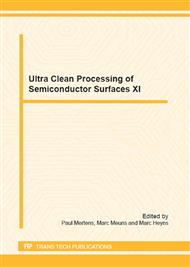p.247
p.252
p.261
p.265
p.269
p.274
p.277
p.283
p.289
Real-Time Analyses of Metal Contaminations in the ppb-Range
Abstract:
In high-tech processing even smallest concentrations of metal ions in process media are of the utmost significance because they cause expensive production failures. Currently, cost-intensive equipment, special trained staff and time consuming analyses are necessary to detect these contaminations in order to avoid failures. The Centers of Excellence Nanochem and Sensorics at the University of Applied Sciences Regensburg (owner of patent PCT/EP2010/064833) and their industrial partner Micro-Epsilon GmbH are developing a new miniaturized measurement device which allows cost-effective real-time analysis of fluidic media for the first time. The system is fully automated and can be directly connected to wet-etch benches. Hence it allows continuous real-time surveillance of metal contaminations in the ppb-range through absorption spectroscopy in process media. For this purpose a very small sample amount of the process medium and a specific complexing agent are mixed together. This leads to an increase in the molar extinction coefficients and though even smallest contaminations become visible. The main parts of our development are the simulation of the different system components, their production and chemical analyses with the evaluation model.
Info:
Periodical:
Pages:
269-273
Citation:
Online since:
December 2012
Authors:
Price:
Сopyright:
© 2013 Trans Tech Publications Ltd. All Rights Reserved
Share:
Citation:


